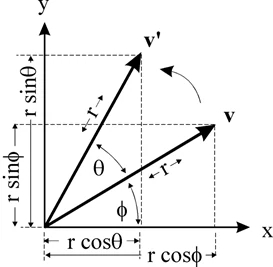暗黑模式
坐标变换(2D)
教程3DWebGL
变换(Transforms)和仿射变换(Affine Transforms)
在计算机图形学中,变换(Transforms)是一种用于改变对象位置、方向、大小或形状的操作。它们是将对象从一个坐标空间变换到另一个坐标空间的数学操作。而仿射变换(Affine transformations)是一种特殊类型的变换,它保持了原始对象的直线性质和平行性质。仿射变换是一种线性变换,意味着它保持了原始对象的直线性质和平行性质。在仿射变换中,原始对象的平行线在变换后仍然是平行的。在计算机图形学中,仿射变换通常用于实现基本的图形操作,如对象的平移、旋转和缩放。它们也常用于构建更复杂的变换操作,如透视投影等。
仿射变换(Affine transformations) 是一种线性变换,它包括以下几种基本变换:
- 平移(Translation):沿着坐标轴移动对象的位置。
- 旋转(Rotation):围绕一个点或轴线旋转对象。
- 缩放(Scaling):增加或减少对象的大小。
- 剪切(Shearing):按比例移动对象的顶点,从而改变其形状。
这些变换可以单独应用,也可以组合在一起以实现更复杂的效果。
在二维空间中,仿射变换通常由一个 2x2 的矩阵和一个平移向量(通常表示为一个 2x1 的列向量)组成,表示为:
在三维空间中,仿射变换通常由一个 3x3 的矩阵和一个平移向量(表示为一个 3x1 的列向量)组成,表示为:
平移(Translation)
平移公式推导
旋转(Rotation)
绕Z轴旋转公式推导

缩放(Scale)
缩放公式推导
二维矩阵
平移
平移矩阵推导
注意
代码中存储矩阵数据时,为了方便存储和获取矩阵的某一列,所以代码的实现和数学中矩阵的惯例是不一样的:
- 矩阵的数学表达:js
const some4x4TranslationMatrix_math = [ 1, 0, 0, tx, // row 1 0, 1, 0, ty, // row 2 0, 0, 1, tx, // row 3 0, 0, 0, 1, // row 4 ];1
2
3
4
5
6 - 矩阵的代码实现:js
const some4x4TranslationMatrix_webgl = [ 1, 0, 0, 0, // row 1 = column 1 of math convention 0, 1, 0, 0, // row 2 = column 2 of math convention 0, 0, 1, 0, // row 3 = column 3 of math convention tx, ty, tz, 1, // row 4 = column 4 of math convention ];1
2
3
4
5
6
使用矩阵实现平移:
旋转
旋转矩阵推导
使用矩阵实现平移、旋转:
缩放
缩放矩阵推导
投影
glsl
#version 300 es
in vec2 a_position; // 顶点的原始坐标(本地坐标、模型空间坐标)
uniform float u_heightWidthRatio; // canvas.clientWidth / canvas.clientHeight
void main() {
gl_Position = vec4(a_position, 0.0, 1.0); // gl_Position: clipping space 中的坐标
gl_Position.x *= u_heightWidthRatio; // 修正为 NDC
}1
2
3
4
5
6
7
8
2
3
4
5
6
7
8
观察上面修正 NDC 的方法,发现其实就是对 Y 轴进行的缩放变换(即投影变换),故此我们可以把这一步骤加到平移、旋转、缩放等仿射变换中。
投影矩阵推导
另一种坐标系
前面的例子中,采用的坐标系是以屏幕中心为原点、Y轴朝上为正数,一般在 2D 中是采用另一种坐标系:
- 屏幕左上角为原点
- Y轴朝下为正数
●————————————————————————> X轴
| 原点(0,0,0)
|
|
|
|
|
v Y轴采用 2D 常用坐标系:






